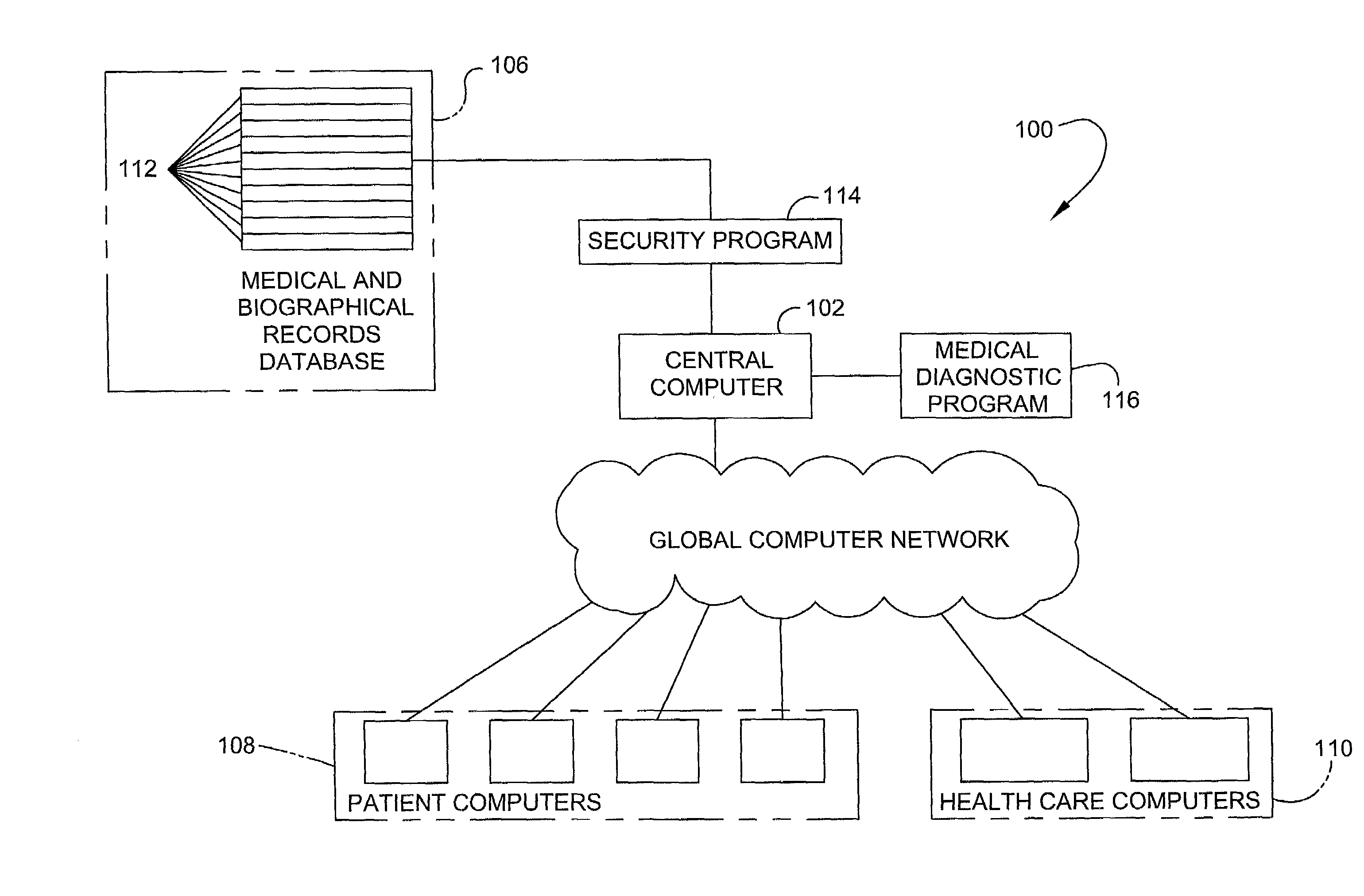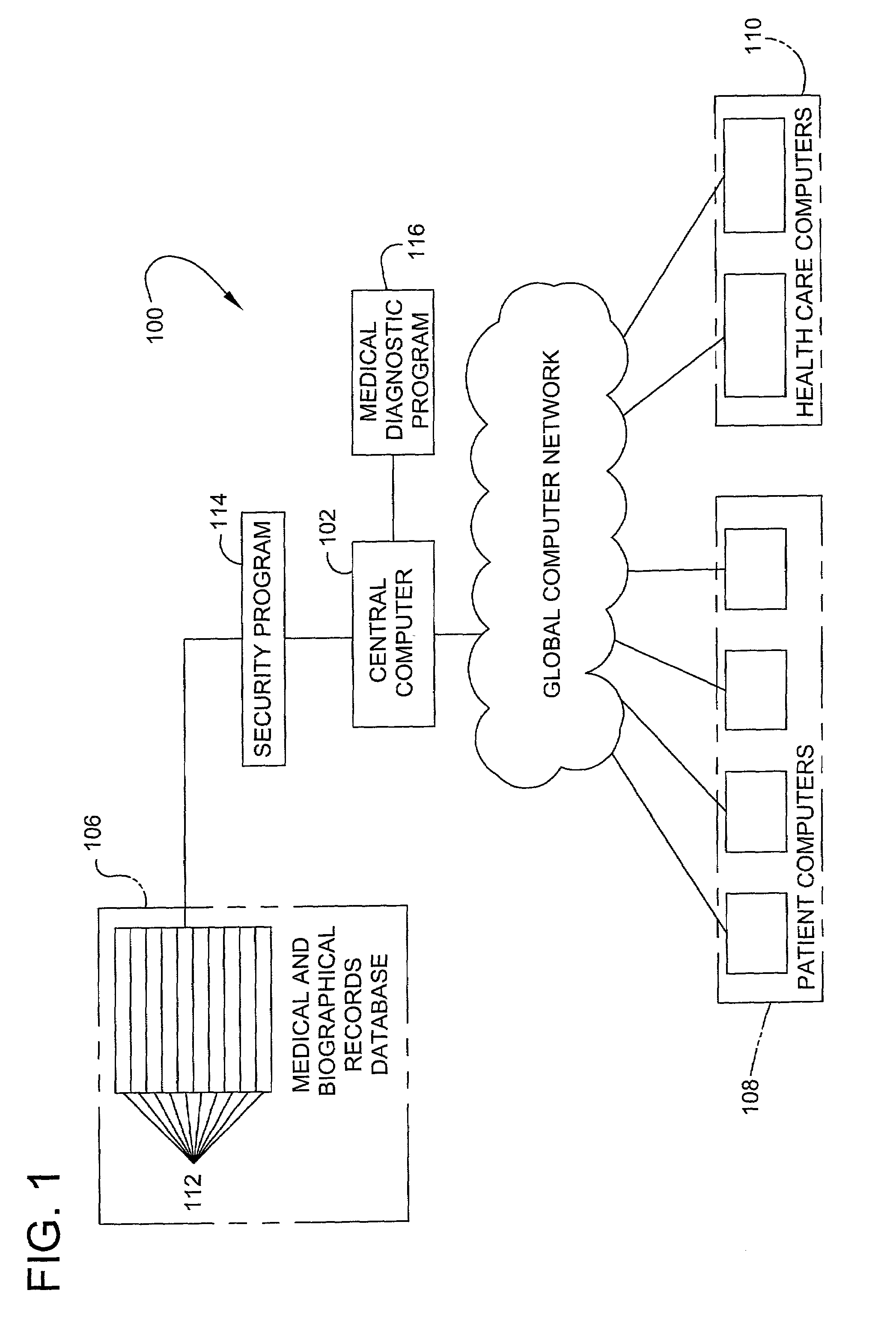Patient-controlled automated medical record, diagnosis, and treatment system and method
a technology of automated medical record and patient, applied in the field of patient-controlled automated medical record, diagnosis, treatment system and method, can solve the problem of limiting the access to the medical and biographical record database to individual patients
- Summary
- Abstract
- Description
- Claims
- Application Information
AI Technical Summary
Benefits of technology
Problems solved by technology
Method used
Image
Examples
example i
Structuring a Health Diagnostic Program
[0145]An example of the health diagnostic program of the present invention may be structured in a variety of ways. One example, though not intended to be limiting, includes four elements. These elements include 1) a diagnostic questioner, 2) question codification, 3) stratification of body parts, and 4) weight analysis of responses to diagnostic questions.
1) Questioner
[0146]Not all questions must be applied to each query. Some questions may require repetition at different points in the process to ascertain the validity and consistency of responses, and confirm interviewee understanding of the question. This approach makes the process programmable, statistically analyzable and standardizable. Six areas are considered, divided into sectors, subsectors, sections and subsections as follows:[0147]1—What[0148]2—Where[0149]3—When[0150]4—Whom[0151]5—How[0152]6—Why
2. Question Codification
[0153]Questions are codified to facilitate organization of the inf...
example 2
Diagnostic Questioning
Symptoms
[0167]Presenting symptoms: headache, fever, vomiting, feeling awful.
[0168]Sufficient information are generated according to the medical diagnostics program to reach, by logical progression of inclusion, potential diagnoses that can be ranked from most likely to least likely. Potential diagnoses are ranked by correlating information received from individuals regarding subsections of different sectors and diagrams or graphical information provided by the individual, in a pattern of basic questions such as what, where, when, whom, how, and why. Questions can also be analyzed in reverse to determine potential diagnoses, such that by eliminating what is not, what is left is what it may be a potential diagnosis in the order of least to most likely.
[0169]As an example, an individual may be initially asked general questions such as the individual's sex, age, height, weight and so forth.
[0170]Once general questions have been asked and answered, questions may be ...
example 3
Insurance and Finance System
[0185]Financing of health care has been a controversial issue of care in the last century. The controversy persists into this century since a reasonable solution has not been developed. As it exists, the present system is on the verge of collapse. Current methods of financing health care are inefficient, expensive, inequitable, complex, and top-heavy. Patchwork repairs have been made throughout the last century, gradually worsening the process. A solution to the dilemma would be of substantial benefit to society.
[0186]To solve the problems associated with financing health care, a number of assumptions can be made to correct some of the potential inequities and barriers. Some of these assumptions include:[0187]1) Health care insurance is a privilege obtained by participating financially in proportion to income and wealth.[0188]2) Basic health care may be offered free at government or society's discretion to those too poor to participate financially. Provis...
PUM
 Login to View More
Login to View More Abstract
Description
Claims
Application Information
 Login to View More
Login to View More - R&D
- Intellectual Property
- Life Sciences
- Materials
- Tech Scout
- Unparalleled Data Quality
- Higher Quality Content
- 60% Fewer Hallucinations
Browse by: Latest US Patents, China's latest patents, Technical Efficacy Thesaurus, Application Domain, Technology Topic, Popular Technical Reports.
© 2025 PatSnap. All rights reserved.Legal|Privacy policy|Modern Slavery Act Transparency Statement|Sitemap|About US| Contact US: help@patsnap.com



